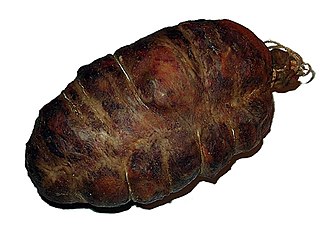Botillo
The botillo is a meat product made with chopped pieces from the cutting of the pig, seasoned and stuffed into the caecum of the pig, which is then smoked and semi-cured. It is protected under the Botillo de El Bierzo brand, in the Leonese regions of El Bierzo and Laciana. There are also variants in the Galician provinces of Orense and Lugo, where, as in Trás-os-Montes (Portugal), it is named botelo or butelo, and in Asturias, where it is called butieḷḷo or butiellu, recently also being made in other zones.
Similar products also appear in the gastronomy of other regions of Spain and Portugal, sometimes under other names.
Features
PGI: Botillo from El Bierzo
According to the official regulations for the El Bierzo botillo, the outer shape of the botillo is defined by the shape of the casing used (blind), normally oval. The weight will oscillate between 500 grams and one and a half kilos and the consistency will be firm and with an intense red cut. The humidity will be below 65%, the fat ratio of the dry extract will be less than 48% of the mass of the product while the protein will be around 37%. After cooking, the smells of cooked lean meat, salting and natural spices will predominate, with its stringy and juicy texture not being homogeneous.
In the municipality of Bembibre in Berciano, the National Festival of Exaltation of the Botillo has been celebrated since 1972 during the month of February. There are other festivals, celebrations and prizes in which the botillo is the protagonist in several towns in El Bierzo, among which the Fabero botillo Festival stands out, in Folgoso de la Ribera, Torre del Bierzo, Boeza and the tastings organized by the Brotherhood Gastronomy of the Real Botillo del Bierzo even outside of Spain.
Other variants
There are other foods in other regions with many similarities, with other names, shapes, and differences cured by Asturias, Galicia, a large part of the province of León, part of the province of Zamora, in Salamanca ("banduju& #34;) or in Extremadura. The name of "botillo" it is the result of the hispanicization of the term in the local ballads; because in El Bierzo it is also known as "butelo" or "butietsu"/"butiellu" depending on whether we are in Ancares, in Palacios del Sil or in the Sierra de Gistredo, and in Galicia it is called "butelo" or "throw it away" according to the variants of Galician spoken in the provinces of Lugo or Orense.
Also, with more or less similarity in appearance, content and elaboration, they are known by the names "l.loscu/Tsoscu ", " butiellu" in areas of Asturias and North of León (Laciana, Omaña, Babia, Luna, Ribera del Órbigo or "llosco". In Cangas del Narcea (Asturias), it is called butiecho.
In Extremadura, there is the rib crop, a sausage with which a similar dish is also made with cabbages.
The sausage from the province of Zamora called "pastor" (name that, together with botillo, they give it in Valdeorras and La Cabrera), it is made with pork ribs that are included in the pork casing together with paprika. These are usually put in the kitchens with firewood so that they smoke. They are usually consumed after some curing time. The bones take on a cartilaginous texture due to this curing process, which is why they can be taken in slices.
The sausage from Trás-os-Montes, in Portugal, is also made with pig bones and has a Protected Indication, it is called "botelo”, “butelo”, “bulho" or (in Mirandés) “butielho”.
Processed
The elaboration and healing will be carried out in a minimum period of five days and consists of four phases:
- Selection and stumbling of raw material.
- Adobate and sausage, the salt is added, the sweet, not spicy paprika, garlic, and other natural spices, proceeding to the mingled and mingled of the mondongo. It then proceeds to its intoxication in the blind of the pig that previously, in turn, has been seasoned and marinated, to get the color and ideal conservation of the gut.
- Smoked, with smoke from natural wood of oak or oak.
- Drying, for two days in dryers prepared for this purpose, with the purpose of eliminating water and the product acquiring greater consistency.
Contenido relacionado
Blood sausage
Gastronomy of Mexico
Starch




